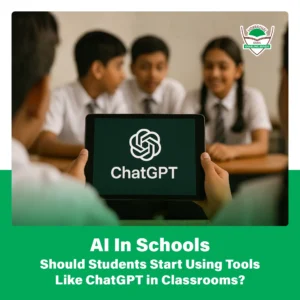Pros and Cons of AI Tools in Education
Artificial Intelligence (AI) is no longer a futuristic concept—it is now reshaping industries, redefining how we communicate, and increasingly transforming the classroom experience. From AI-powered tutoring to automated lesson planning and intelligent content generation, the education sector is seeing rapid adoption of these tools. But this progress also brings a pressing question to the forefront: Should schools embrace AI as an educational ally, or proceed with caution?
This blog explores both the opportunities and challenges AI presents for students, teachers, and schools—especially those aiming to provide holistic education.
The Rise of AI in Education: A Data-Driven View
AI is already making a significant impact in schools and learning environments worldwide. According to a recent global survey by the Digital Education Council, 86% of students reported using AI tools to support their learning, with over 54% relying on them weekly. A staggering 89% of students admitted to using ChatGPT for homework, citing it as more helpful than traditional tutoring models.
Teachers and administrators are also turning to AI. In the United States, a RAND Corporation study found that 25% of teachers and nearly 60% of school principals had adopted AI for planning or instruction. In K–12 classrooms specifically, 18% of teachers use AI regularly, while another 15% have experimented with it.
These numbers suggest that AI in education is not just a trend—it’s becoming an integral part of how schools function. But with such fast-paced adoption, it is critical to assess the broader implications.
Advantages of AI in Schools
Personalized Learning and Instant Feedback
AI platforms can adapt lessons based on each student’s pace and learning style. This personalization helps close learning gaps and improves retention. Research shows adaptive learning systems can boost academic outcomes by up to 30%. AI also provides instant feedback, helping students correct errors in real-time rather than waiting for manual reviews.
Improved Efficiency for Teachers
AI can automate routine administrative tasks—like grading quizzes, creating lesson plans, or organizing learning materials—freeing up teachers to focus on classroom engagement and student support. A pilot program in South Australia found AI tools saved teachers up to five hours per week and led to a 47% increase in student interaction.
Supporting Diverse Learners
AI can make education more inclusive by offering assistive tools like speech-to-text, captioning, and visual learning aids. For children with learning differences or language barriers, AI can create more accessible learning environments.
Encouraging Conceptual Understanding
AI-powered visual simulations, interactive explanations, and idea-generation tools help students grasp complex topics. In environments where conceptual clarity is prioritized—such as Vidyanchal’s activity-based learning in early years—AI can complement classroom learning.
The Drawbacks and Cautions of AI Adoption
Risk of Cognitive Dependency
The growing reliance on AI raises a red flag: students may stop developing core cognitive skills. A recent Australian study found students using AI displayed a 47% drop in neural engagement. Alarmingly, 83% of these students could not recall or explain their work when asked, compared to just 10% of those who completed tasks independently.
This digital dependency could undermine memory retention, creativity, and problem-solving skills—core competencies in any educational setting.
Erosion of Critical Thinking
Wharton School research has shown that students who used AI for math exam prep underperformed compared to their peers. The automated assistance reduced the need to reason through problems, leading to weaker foundational understanding.
At Vidyanchal, where conceptual clarity and cognitive application are central to learning across subjects, critical thinking must remain a priority—AI should assist, not replace, the learning process.
Academic Integrity Concerns
With AI tools capable of generating full essays, reports, and answers, the lines between support and plagiarism are blurring. Over 70% of educators surveyed globally consider AI-generated homework a form of academic dishonesty. This not only threatens learning integrity but also compromises the fairness of assessments.
Equity and the Digital Divide
AI requires infrastructure—devices, reliable internet, and guidance. For schools and families in under-resourced areas, this could widen educational inequality. Principals in higher-poverty districts report significantly lower AI adoption rates.
Privacy and Data Security
AI tools often collect user data to “learn” and personalize experiences. Without strict data privacy frameworks, sensitive information about students can be exposed or misused. Parents and educators are rightfully concerned about who owns the data and how it is used.
How Should Schools Approach AI?
The question is not whether AI should be used—but how. A thoughtful, structured, and ethical integration is essential. Here are a few guiding principles schools like Vidyanchal can consider:
Build Digital Literacy
Students should be taught to evaluate AI-generated content critically. This includes understanding biases, cross-verifying facts, and reflecting on their own inputs and assumptions. Encouraging digital responsibility is as important as encouraging creativity.
Introduce Transparent Use
Schools can ask students to disclose their AI interactions—by submitting prompts alongside AI-assisted assignments, for instance. This promotes honesty and accountability without penalizing the use of helpful tools.
Blend AI with Human-Led Instruction
AI can enhance, not replace, the teacher’s role. Schools must retain space for face-to-face learning, group discussions, and teacher-led explanation. In fact, the importance of human mentorship was recently underlined in Vidyanchal’s blog on bullying prevention and emotional support, where safe learning environments depend heavily on human relationships.
Teacher Training and Institutional Policy
Before deploying AI tools at scale, schools should train staff on ethical usage, bias prevention, and classroom integration. Institutions also need clear AI policies—governing usage, data safety, and appropriate student conduct.
Promote Balanced Use
At Vidyanchal, a balanced educational philosophy is already in place, as seen in blogs on healthy screen habits and productive time management. That balance can extend to AI—encouraging its thoughtful use without replacing physical activity, peer learning, or real-world exploration.
Conclusion: Embracing AI with Intention
Artificial Intelligence has the potential to revolutionize education—but only if introduced with care, guidance, and purpose. Schools must not rush into blanket adoption without frameworks that preserve student agency, cognitive development, and emotional well-being.
For institutions like Vidyanchal School, where holistic education includes ethics, empathy, and intellectual growth, AI should serve as a tool—never a substitute. It must support, not overshadow, the human experiences that make education meaningful.
Used wisely, AI can be a powerful ally in helping students think critically, solve problems, and express themselves more effectively. But it is the responsibility of educators, parents, and institutions to ensure that this technology enhances learning, rather than diminishes it.











